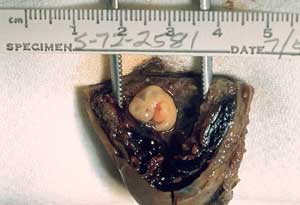Circumstances: Life in Danger
The situation of a pregnant woman’s life being in danger is extremely rare, but of course serious. Since both the woman and her child are human beings, they are equal in value and we must strive to protect both.
When deciding how to ethically intervene in a pregnancy where there is a life-threatening medical problem, one should be guided by this basic moral principle: One may not commit a wrong action in order to bring about some good effect. One can only commit good actions, or neutral actions, in order to bring about a good effect. This concept is better known as “the ends do not justify the means.”
To give an example, one may not kill a 5-year-old (a wrong action) in order to obtain his heart for an ill 6-year-old, thus saving the older child’s life (a good effect).
Applying that principle to a situation where a pregnant woman’s life is in danger, one may not directly and intentionally kill the innocent child because to do so would be to commit a wrong action. One may, however, commit good or neutral actions. For example, removing a cancerous uterus is a good action as it addresses a pathology within the woman’s body. Although it has the effect of saving the mother’s life, it may also have the effect of the child dying (e.g., if it’s prior to viability). The bad effect, the child’s death, is foreseen but unintended. If the child could be saved, efforts should be made to do so.
Whether or not it is moral to perform an action that can have both a good and bad effect is governed by “the principle of double effect” outlined by Hayes et al., in their medical ethics book:
Under the principle of the two-fold or double effect, the science of ethics lays down certain conditions which must be fulfilled to justify performing an action that has both a good and bad effect. These are the conditions:
- The action to be performed must be morally good in itself or at least morally indifferent or neutral.
- The good effect must not come about as a result of the evil effect, but must come directly from the action itself.
- The good must be willed, and the evil merely allowed or tolerated.
- The good effect must be at least equivalent in importance to the evil effect. In other words, there must be sufficient reason for permitting the evil effect to occur.
Although the conditions may sound complicated, all of us apply them frequently. A little boy cuts his hand, and his mother puts an antiseptic on the cut. This action has two effects: it causes the boy pain and it wards off infection. Although the mother did not realize it, she actually used the four principles above. She performed an action that was good in itself, namely, putting antiseptic on the boy’s hand. The good effect did not come from the pain but rather from the use of the antiseptic.
The mother did not will to giver her child pain, but only desired to help him. Finally, the good effect of preventing infection far outweighed the evil effect of the antiseptic’s sting.
When the Principle Does Not Apply
Now let us look at a situation which would not be permitted under this principle. A pregnant woman is suffering from pernicious vomiting, a condition that can easily be solved by aborting the child. However, such a solution is not morally permissible and violates the double-effect principle in the following ways:
- The action is not morally good or even neutral; it is evil, it is an attack on innocent human life.
- The good effect, namely, the health of the mother, follows from the evil effect. The mother is cured by the death of her child.
- The evil effect is willed and not merely tolerated.
- The death of the baby is not equivalent in importance to stopping the mother’s vomiting.
It should be noted that such a condition can be treated with hospitalization, bed rest, the use of IV fluids, and antiemetic medications. There is no need for abortion, although this is still recommended in some circles. It is not morally permissible, however, because a good end never justifies an evil means. We may not do evil in order that good may come from it.
Case 2: A married woman discovers that her pregnancy is not developing normally, that it is occurring in the fallopian tube instead of in the uterus. If the doctor does nothing, the tube will swell further and finally rupture, possibly causing the death of the mother. The only cure is to remove the tube promptly, which will save the mother’s life and result in the death of the baby. Is it moral for the doctor to operate? The answer is yes.

- The purpose of the operation is good, to remove a pathological organ which is a threat to the life of the mother.
- The good effect of saving the mother’s life does not come from the evil effect of killing the baby.
- The surgeon does not will to kill the baby; his death is an unintended side effect of the operation that is merely permitted.
- The good effect of saving the mother’s life is at least equivalent to the evil effect of the baby’s death.1
If abortion became illegal, there would be no need to have a clause in the law providing an exception for “when the woman’s life is in danger.” As has been described above, the measures taken to address such a crisis do not constitute abortion as we know it: directly and intentionally killing an innocent human being. That is always wrong.
Back to Circumstances of a Crisis Pregnancy
- Rev. Edward Hayes, Rev. Msgr. Paul Hayes, Dorothy Kelly, R.N, and James Drummey, Catholicism & Ethics: A Medical/Moral Handbook (Massachusetts: C.R. Publications Inc., 1997) 53-56.
